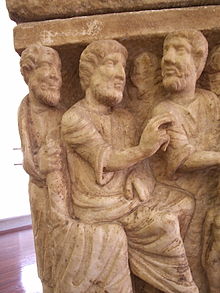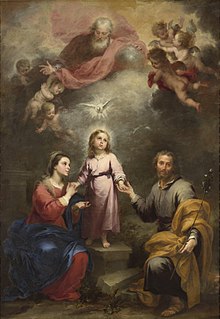The Christian doctrine of the Trinity (Latin: Trinitas, lit. 'triad', from Latin: trinus 'threefold')[1] is the central doctrine concerning the nature of God in most Christian churches, which defines one God existing in three coequal, coeternal, consubstantial divine persons:[2][3] God the Father, God the Son (Jesus Christ) and God the Holy Spirit, three distinct persons sharing one homoousion (essence) "each is God, complete and whole."[4] As the Fourth Lateran Council declared, it is the Father who begets, the Son who is begotten, and the Holy Spirit who proceeds.[5][6][7] In this context, the three persons define who God is, while the one essence defines what God is.[8][9] This expresses at once their distinction and their indissoluble unity. Thus, the entire process of creation and grace is viewed as a single shared action of the three divine persons, in which each person manifests the attributes unique to them in the Trinity, thereby proving that everything comes "from the Father," "through the Son," and "in the Holy Spirit."[10]
This doctrine is called Trinitarianism and its adherents are called Trinitarians, while its opponents are called antitrinitarians or nontrinitarians. Christian nontrinitarian positions include Unitarianism, Binitarianism and Modalism.
While the developed doctrine of the Trinity is not explicit in the books that constitute the New Testament, the New Testament possesses a triadic understanding of God[11] and contains a number of Trinitarian formulas.[12][13] The doctrine of the Trinity was first formulated among the early Christians and fathers of the Church as they attempted to understand the relationship between Jesus and God in their scriptural documents and prior traditions.[14]
Though the Trinity is mainly a Christian concept, Judaism has had parallel views, especially among writings from the kabbalah tradition.[15]
https://en.wikipedia.org/wiki/Trinity
https://en.wikipedia.org/wiki/Trinity
https://en.wikipedia.org/wiki/Saint_Patrick#Legends
https://en.wikipedia.org/wiki/Three_Pure_Ones
https://en.wikipedia.org/wiki/Triple_deity
https://en.wikipedia.org/wiki/Trinitarian_universalism
https://en.wikipedia.org/wiki/Triquetra
“Then the Lord rained on Sodom and Gomorrah sulfur and fire from the Lord out of heaven. Genesis 19:24 ESV
https://en.wikipedia.org/wiki/Trinity
Early Christianity
Before the Council of Nicaea
While the developed doctrine of the Trinity is not explicit in the books that constitute the New Testament, it was first formulated as early Christians attempted to understand the relationship between Jesus and God in their scriptural documents and prior traditions.[14]
An early reference to the three “persons” of later Trinitarian doctrines appears towards the end of the first century, where Clement of Rome rhetorically asks in his epistle as to why corruption exists among some in the Christian community; "Do we not have one God, and one Christ, and one gracious Spirit that has been poured out upon us, and one calling in Christ?" (1 Clement 46:6).[67] A similar example is found in the first century Didache, which directs Christians to "baptize in the name of the Father and of the Son and of the Holy Spirit".[68]
Ignatius of Antioch similarly refers to all three persons around AD 110, exhorting obedience to "Christ, and to the Father, and to the Spirit".[69] Though all of these early sources do reference the three persons of the Trinity, none articulate full divinity, equal status, or shared being as elaborated by Trinitarians in later centuries.[citation needed]
The pseudonymous Ascension of Isaiah, written sometime between the end of the first century and the beginning of the third century, possesses a "proto-trinitarian" view, such as in its narrative of how the inhabitants of the sixth heaven sing praises to "the primal Father and his Beloved Christ, and the Holy Spirit".[70]
Justin Martyr (AD 100 – c. 165) also writes, "in the name of God, the Father and Lord of the universe, and of our Saviour Jesus Christ, and of the Holy Spirit".[71] Justin Martyr is the first to use much of the terminology that would later become widespread in codified Trinitarian theology. For example, he describes that the Son and Father are the same "being" (ousia) and yet are also distinct faces (prosopa), anticipating the three persons (hypostases) that come with Tertullian and later authors. Justin describes how Jesus, the Son, is distinguishable from the Father but also derives from the Father, using the analogy of a fire (representing the Son) that is lit from its source, a torch (representing the Father).[72] At another point, Justin Martyr wrote that "we worship him [Jesus Christ] with reason, since we have learned that he is the Son of the living God himself, and believe him to be in second place and the prophetic Spirit in the third" (1 Apology 13, cf. ch. 60).
The first of the early Church Fathers to be recorded using the word "Trinity" was Theophilus of Antioch writing in the late 2nd century. He defines the Trinity as God, his Word (Logos) and his Wisdom (Sophia)[73] in the context of a discussion of the first three days of creation, following the early Christian practice of identifying the Holy Spirit as the Wisdom of God.[74]
The first defense of the doctrine of the Trinity was by Tertullian, who was born around 150–160 AD, explicitly "defined" the Trinity as Father, Son, and Holy Spirit and defended his theology against Praxeas,[75] although he noted that the majority of the believers in his day found issue with his doctrine.[76]
St. Justin and Clement of Alexandria referenced all three persons of the Trinity in their doxologies and St. Basil likewise, in the evening lighting of lamps.[77]
Origen of Alexandria (AD 185 – c. 253) has often been interpreted as Subordinationist — believing in shared divinity of the three persons but not in co-equality. (Some modern researchers have argued that Origen might have actually been anti-Subordinationist and that his own Trinitarian theology inspired the Trinitarian theology of the later Cappadocian Fathers.)[78][79]
The concept of the Trinity can be seen as developing significantly during the first four centuries by the Church Fathers in reaction to theological interpretations known as Adoptionism, Sabellianism, and Arianism. Adoptionism was the belief that Jesus was an ordinary man, born of Joseph and Mary, who became the Christ and Son of God at his baptism. In 269, the Synods of Antioch condemned Paul of Samosata for his Adoptionist theology, and also condemned the term homoousios (ὁμοούσιος, "of the same being") in the modalist sense in which he used it.[80]
Among the nontrinitarian beliefs, the Sabellianism taught that the Father, the Son, and the Holy Spirit are essentially one and the same, the difference being simply verbal, describing different aspects or roles of a single being.[81] For this view Sabellius was excommunicated for heresy in Rome c. 220.
First Council of Nicaea (325)
In the fourth century, Arianism, as traditionally understood,[c] taught that the Father existed prior to the Son who was not, by nature, God but rather a changeable creature who was granted the dignity of becoming "Son of God".[82] In 325, the First Council of Nicaea adopted the Nicene Creed which described Christ as "God of God, Light of Light, very God of very God, begotten, not made, being of one substance with the Father", and the "Holy Ghost" as the one by which "was incarnate ... of the Virgin Mary".[83][84] ("the Word was made flesh and dwelled among us"). About the Father and the Son, the creed used the term homoousios (of one substance) to define the relationship between the Father and the Son. After more than fifty years of debate, homoousios was recognised as the hallmark of orthodoxy, and was further developed into the formula of "three persons, one being".
The Confession of the First Council of Nicaea, the Nicene Creed, said little about the Holy Spirit.[85] At the First Council of Nicea (325) all attention was focused on the relationship between the Father and the Son, without making any similar statement about the Holy Spirit. In the words of the creed:
We believe in one God, the Father Almighty, Maker of all things visible and invisible. And in one Lord Jesus Christ, the Son of God, begotten of the Father [the only-begotten; that is, of the essence of the Father, God of God,] Light of Light, very God of very God, begotten, not made, being of one substance with the Father; ... And [we believe] in the Holy Ghost. ...
First Council of Constantinople (381)
Later, at the First Council of Constantinople (381), the Nicene Creed would be expanded, known as Niceno-Constantinopolitan Creed, by saying that the Holy Spirit is worshiped and glorified together with the Father and the Son (συμπροσκυνούμενον καὶ συνδοξαζόμενον), suggesting that he was also consubstantial with them:
We believe in one God, the Father Almighty, Maker of heaven and earth, and of all things visible and invisible. And in one Lord Jesus Christ, the only-begotten Son of God, begotten of the Father before all worlds (æons), Light of Light, very God of very God, begotten, not made, being of one substance with the Father; ... And in the Holy Ghost, the Lord and Giver of life, who proceedeth from the Father, who with the Father and the Son together is worshiped and glorified, who spake by the prophets ...[86]
The doctrine of the divinity and personality of the Holy Spirit was developed by Athanasius in the last decades of his life.[87] He defended and refined the Nicene formula.[85] By the end of the 4th century, under the leadership of Basil of Caesarea, Gregory of Nyssa, and Gregory of Nazianzus (the Cappadocian Fathers), the doctrine had reached substantially its current form.[85]
https://en.wikipedia.org/wiki/Trinity




No comments:
Post a Comment